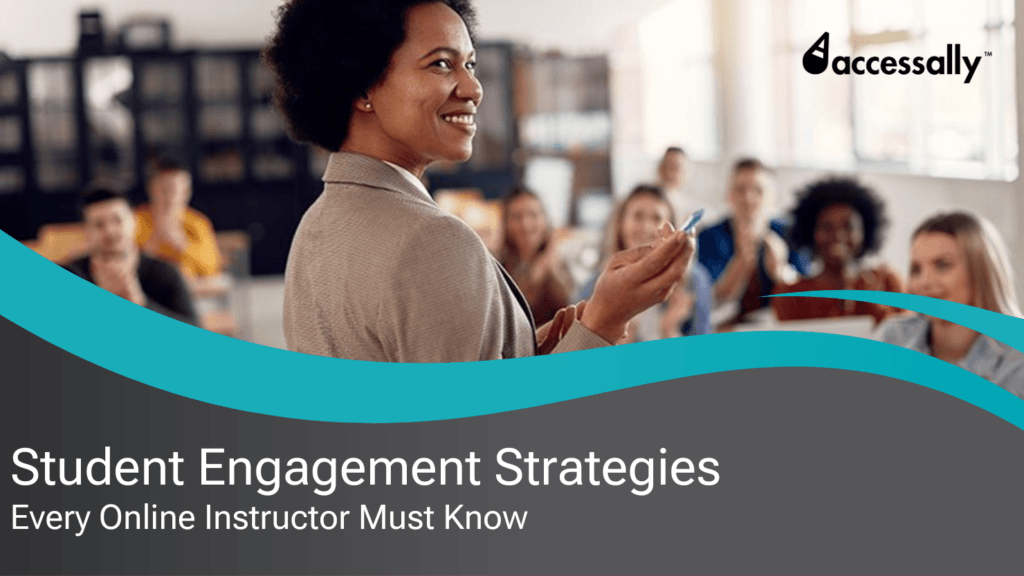When it comes to learning something new, the procrastinating trait touches the sky. And it gets even more challenging if you are trying to learn something online.
Students who don’t feel engaged or attached to a course are more likely to drop out. But that’s not something you want as an online course creator. And that’s where student engagement strategies come in.
Lack of physical presence, potential distractions, and a feeling of isolation can all contribute to a decline in student motivation and participation.
But in this blog, we’ll go over those student engagement strategies that can tackle all these problems for your LMS.
Regardless of your online teaching stage, this blog will help you create a more interactive and fulfilling learning environment for your students.
Understanding Learning Styles to Determine Online Student Engagement Strategies
To effectively engage students, you must first understand that not all students learn the same way. There are four primary learning styles that influence how individuals absorb, process, and retain information:
Visual Learners: These students learn best through images, diagrams, and visual representations of information. They benefit from seeing the content displayed in a way that allows them to make connections and visualize concepts.
Auditory learners: These types of learners prefer to learn by listening. They thrive in environments where information is delivered through lectures, discussions, and audio materials.
Kinesthetic Learners: These learners are hands-on and engage best through physical activities. They learn by doing, experimenting, and experiencing the content in a tangible way.
Reading/Writing Learners: Students with this learning style prefer to interact with text. They engage deeply with written materials and are likely to excel when given opportunities to read, write, and take notes.
4 Must-Know Online Student Engagement Strategies
Understanding the different learning styles allows educators to tailor their teaching strategies to meet their students’ diverse needs better. Yet, the numerous methods and techniques might lead you to worry about what’s the right path for ensuring student engagement.
That’s why we have done the necessary research and compiled a list of the four must-know student engagement strategies. These strategies will not only boost student engagement but also help with student retention.
1. Create an Active Learning Environment for Each Learning Style
Whether your students are visual, auditory, kinesthetic, or reading/writing learners, tailoring your teaching methods to meet their specific needs can transform passive learning into an interactive and dynamic experience. And here are some tips that can help you along the way:
Implement Multimedia Resources: Incorporate a mix of videos, infographics, podcasts, and interactive activities to cater to visual, auditory, and kinesthetic learners alike. For example, you might present a lesson using a video for visual learners, followed by a podcast discussion for auditory learners, and a hands-on activity for kinesthetic learners.
Use Varied Instructional Methods: Rotate between lectures, discussions, group work, and individual assignments to engage students with different learning preferences. For example, a reading/writing learner might benefit from a detailed study guide, while a kinesthetic learner could engage more with a simulation or lab activity.
Adapt Content Delivery to Suit Different Styles: When planning your course content, think about how you can present the same material in different formats. Provide transcripts for videos, visual summaries for lectures, and interactive quizzes that allow students to apply what they’ve learned to suit their learning style.
2. Incorporating Interactive Elements into Your Course Design
Interactivity is a cornerstone of effective online education. It is an important student engagement strategy because, unlike traditional classroom settings where students can physically engage with the material and their peers, online courses require intentional design to keep students active and involved.
When students participate in activities that require them to apply what they’ve learned, they are more likely to internalize it and stay motivated throughout the course.
To create a dynamic and engaging online learning environment, consider integrating the following interactive elements into your course design:
Quizzes and Polls: These tools provide immediate feedback and help reinforce learning. Quizzes can assess comprehension at the end of a lesson, while polls can be used to gauge student opinions or understanding of specific topics.
Discussion Forums: Forums help to build a student community and encourage students to engage in meaningful discussions with their peers. This interaction can deepen their understanding of the material and allow them to view concepts from different perspectives.
Live Sessions and Webinars: Hosting live sessions or webinars adds a real-time interactive component to your course. These sessions allow students to ask questions, participate in discussions, and connect with the instructor and their peers in a more personal setting.
3. Apply Motivational Theories to Boost Student Engagement
Understanding the psychology behind student motivation can significantly enhance the effectiveness of your engagement strategies. Here are three key motivational theories that can be applied to your online education platform:
Self-Determination Theory (SDT): SDT suggests that people are most motivated when they feel a sense of autonomy, competence, and relatedness. In the context of education, this means that students are more likely to engage in learning activities when they feel in control of their learning process, believe they can succeed, and feel connected to their peers and instructors.
Intrinsic vs. Extrinsic Motivation: Intrinsic motivation comes from within the student, driven by an interest in the subject matter or the joy of learning itself. Extrinsic motivation, on the other hand, is driven by external rewards such as grades, praise, or recognition. Both types of motivation play a role in education, but fostering intrinsic motivation is key to long-term engagement and deep learning.
Growth Mindset: Coined by psychologist Carol Dweck, the growth mindset theory posits that students who believe their abilities can be developed through hard work and perseverance are more likely to embrace challenges and persist in the face of setbacks. Encouraging a growth mindset helps students view learning as a journey, where effort leads to improvement and success.
How to Apply These Motivation Theories in Your Online Course
To create a motivating online course environment, recognize student efforts with praise and rewards like badges, reinforcing positive behaviors and achievements.
Break down content into manageable chunks with clear goals, helping students track progress and feel accomplished.
Foster a growth mindset by emphasizing effort over innate ability, encouraging students to view challenges as growth opportunities, and providing constructive feedback.
This approach boosts motivation, builds resilience, and nurtures a love for learning.
4. Use Technology Tools for Student Engagement Strategies
Technology has revolutionized the way we approach education, making learning more dynamic and accessible. By leveraging the right tools, educators can create a more interactive and engaging learning environment that resonates with students.
Technology allows for real-time feedback, diverse content delivery methods, and collaborative opportunities that were previously unimaginable, all of which contribute to a richer educational experience. It also facilitates remote participation.
Tools You Might Need for Boosting Student Engagement
Several powerful tools can be integrated into your online courses to boost student engagement. To name a few:
LMS Platform: A Learning Management System (LMS) is crucial for organizing course materials, tracking student progress, and facilitating assessments. It serves as the backbone of an online course, offering a centralized hub for both students and instructors.
Online Conference Tool: Tools like Zoom or Microsoft Teams allow for real-time interaction, making it easier to conduct live lectures, discussions, and group projects. They help mimic the classroom experience and keep students engaged through direct communication.
Interactive Quizzing Tools: Incorporating tools that allow for interactive quizzes and gamified learning can significantly increase engagement. These tools make learning fun and competitive, encouraging students to participate more actively and retain information better.
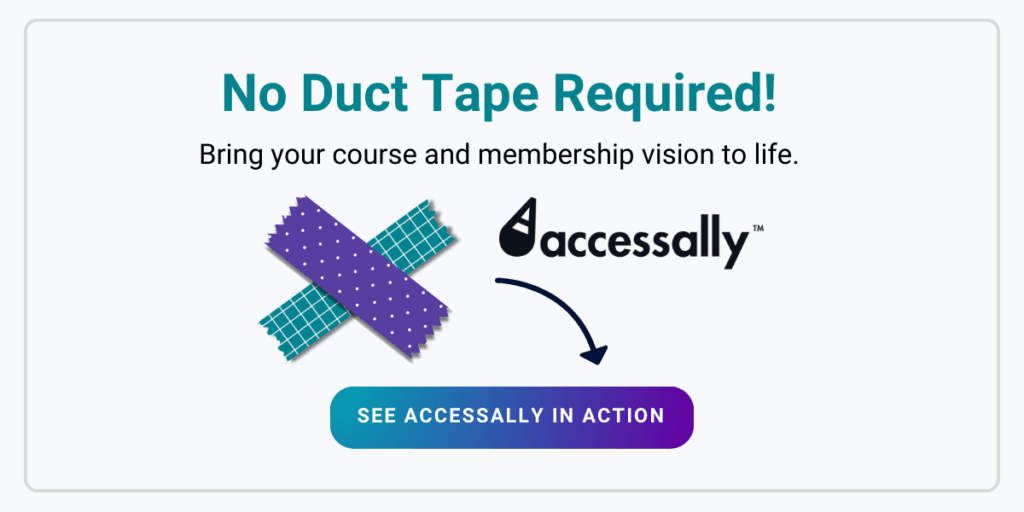

AccessAlly – One Tool for All Your Online Student Engagement Strategy Needs
Now that you know about the strategies and tools needed for successful student engagement strategies, it’s time to show you how you can get started. And the first thing you might need is the right LMS tool.
Choosing the right Learning Management System (LMS) is essential for creating an engaging and effective online learning environment. AccessAlly is a WordPress plugin that not only helps you build interactive courses but also retains users.
Here are some AccessAlly features that can help you implement student engagement strategies without breaking a sweat.
LMS Gamification Features
Gamification involves integrating game-like elements into your course, such as a points system where students earn points for completing activities or reaching milestones.
This feature keeps students motivated by tapping into their competitive instincts. It encourages active participation and persistence, as students strive to accumulate points and achieve higher rankings.
AccessAlly offers gamification features like points, badges, progress bars, quizzes, and more to make your online course interactive.
Badges and Certificates
Badges and certificates serve as a form of recognition, enhancing engagement by giving students tangible rewards for their efforts. These digital badges can be displayed on profiles, providing a sense of accomplishment and encouraging continued participation.
Awarding badges and certificates for course completion and specific achievements is a powerful way to recognize and celebrate student progress. And Accessally lets you add these interactive elements effortlessly.
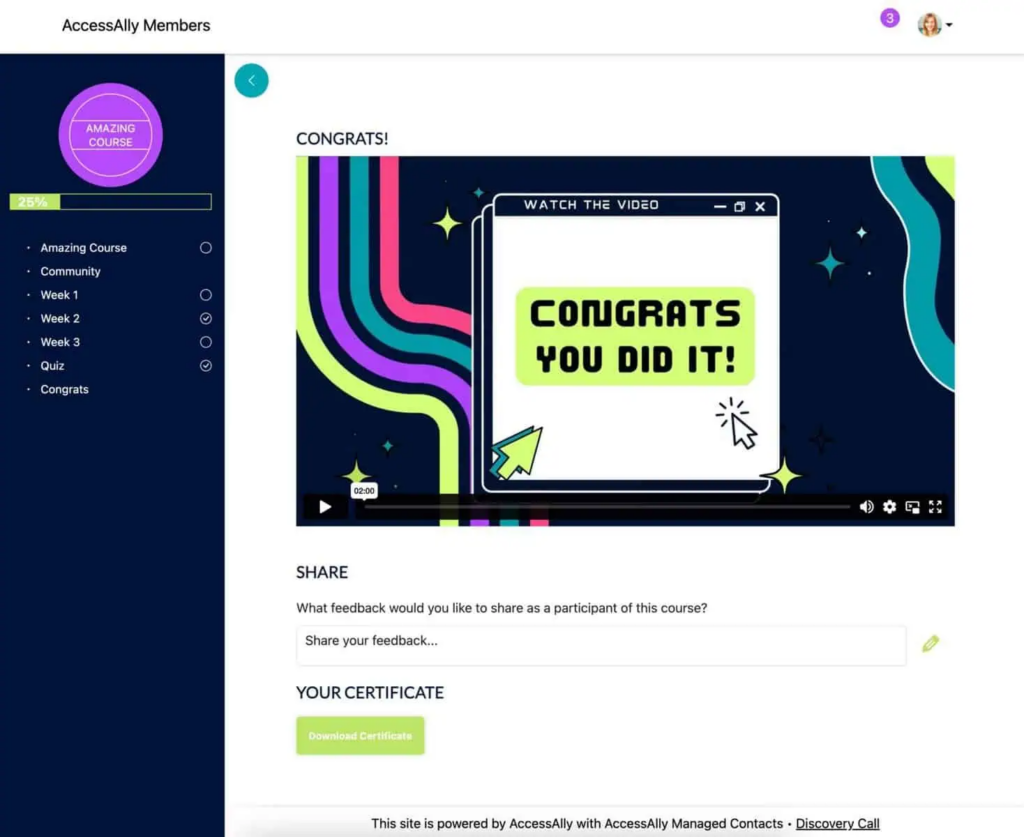

Points and Leaderboards
With Accessally, you can create a credit or point system so students can rank on leaderboards.
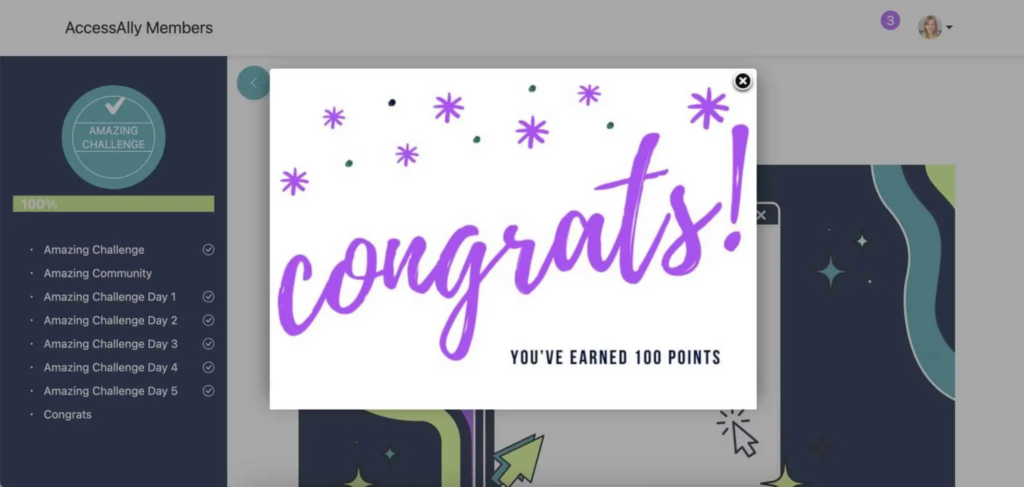

It encourages healthy competition and motivates students to excel. Seeing their names on the leaderboard can inspire students to put in extra effort, driving them to complete tasks and improve their standing.
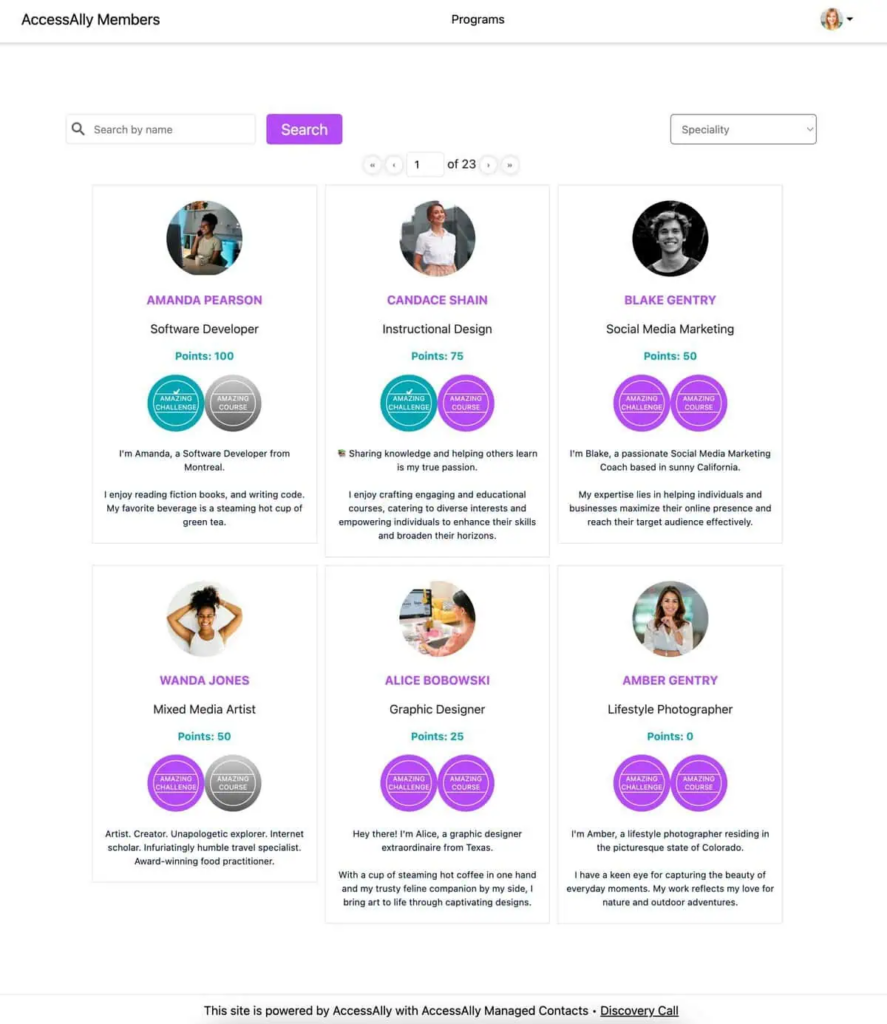

Snappy Login Links™
Simplifying the login process reduces barriers to participation, ensuring that students can easily return to their courses without frustration. A smooth login experience can lead to higher engagement and lower dropout rates.
This is where Accessally also shines brighter than other LMSs by providing snappy login links. These streamlined login links make it easy for students to access the course with minimal hassle.
Customizable Member Profiles for More Personalized Experience
Allowing students to personalize their profiles adds a personal touch to the online learning environment.
Customizable profiles encourage students to take ownership of their learning journey. By adding personal touches, such as photos, bios, and skill levels, students can express themselves and feel more connected to the course community.
Zoom Integration
Say one of your learners is having difficulties and needing one-to-one care. You can easily take those one-to-one classes with Accessally’s Zoom integration through Zapier.
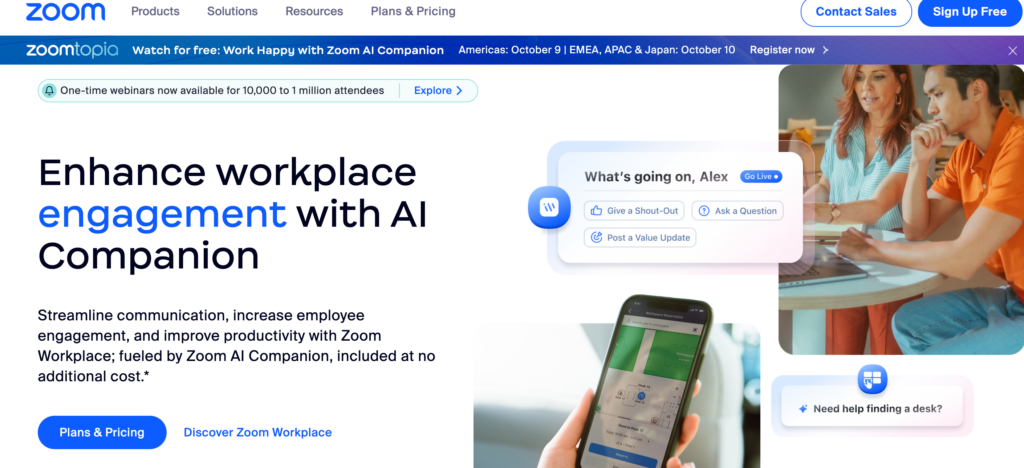

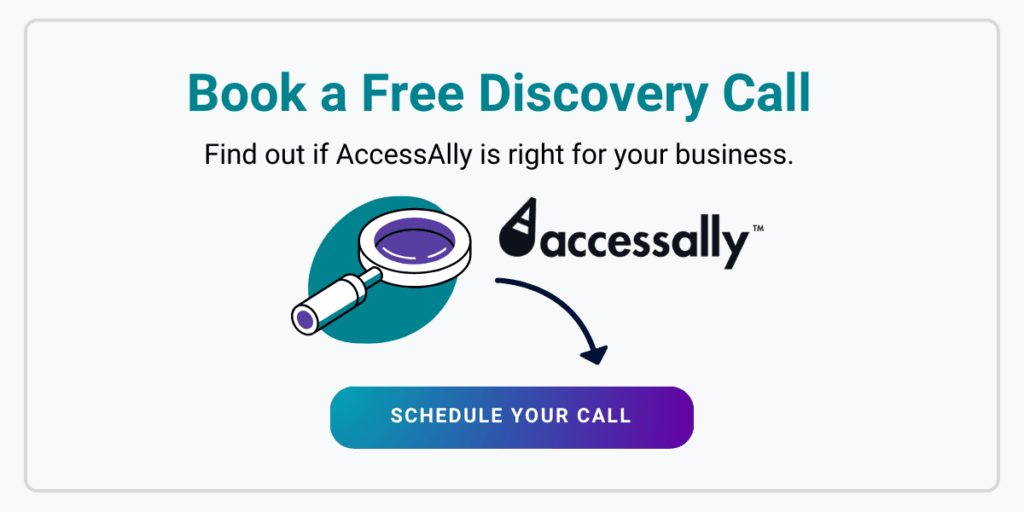

Conclusion
Incorporating these targeted student engagement strategies and tools into your online courses can greatly enhance students’ ability to finish them.
Remember to enhance students’ participation by understanding learning styles, using interactive elements, leveraging technology, and choosing the right LMS features. This will create an environment that excites and motivates students.
Student engagement is essential for the success of online education. Prioritizing engagement improves educational outcomes and fosters a thriving, collaborative learning community.
Now, it’s your turn to apply these strategies in your courses, and share your experiences in the comments below. Let’s keep the conversation going on how to enhance online education together!
